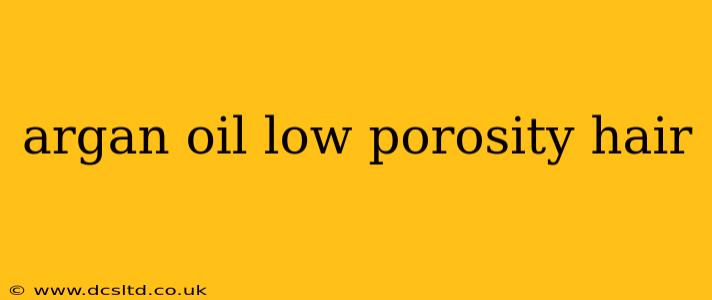Low porosity hair, characterized by tightly sealed cuticles, presents unique challenges when it comes to hydration and product absorption. Finding the right products can feel like a quest, but argan oil, with its rich blend of fatty acids and vitamins, might just be the holy grail you've been searching for. This comprehensive guide will explore how argan oil interacts with low porosity hair, addressing common concerns and offering practical tips for optimal use.
What is Low Porosity Hair?
Before diving into argan oil's benefits, it's crucial to understand low porosity hair. This hair type has tightly overlapping cuticles, making it difficult for moisture and products to penetrate the hair shaft. This can lead to product buildup, a feeling of heaviness, and difficulty in achieving deep hydration. Understanding this characteristic is key to selecting the right products and techniques.
Does Argan Oil Work for Low Porosity Hair?
The answer is a cautious yes. Argan oil's lightweight nature, compared to some other oils, makes it a potentially suitable option for low porosity hair. Its rich fatty acid profile, including oleic and linoleic acid, helps to seal in moisture without weighing the hair down excessively. However, the key lies in how you use it. Overuse can indeed lead to buildup.
How to Use Argan Oil on Low Porosity Hair
The secret to success with argan oil on low porosity hair is moderation and method.
-
Small Amounts: Start with a tiny amount – a few drops are usually sufficient for shoulder-length hair. More isn't necessarily better, especially for low porosity hair.
-
Warm Oil: Gently warming the argan oil can slightly increase its penetration capabilities. You can achieve this by rubbing a small amount between your palms.
-
Pre-Poo Treatment: Apply the warmed oil to dry hair 30 minutes to an hour before washing. This allows the oil to penetrate slightly while your hair is in a more receptive state. Avoid using it as a leave-in conditioner unless you're confident it won't lead to buildup.
-
Deep Conditioning: Argan oil can be incorporated into a deep conditioner, enhancing its moisturizing properties. Mix a small amount of argan oil with your favorite deep conditioner and follow the instructions on the product.
-
Scalp Massage: A gentle scalp massage with argan oil can stimulate circulation and potentially improve the health of your scalp, contributing to healthier hair growth.
-
Leave-in (Use Sparingly): A tiny amount of argan oil can be used on the ends of low porosity hair as a leave-in conditioner but be cautious to avoid overload and buildup.
How Often Should You Use Argan Oil on Low Porosity Hair?
This depends entirely on your hair's individual needs and how it responds to the oil. Start with once a week and monitor for any signs of buildup. If you notice any heaviness or difficulty in styling, reduce the frequency. Listen to your hair—it will tell you what it needs!
Can Argan Oil Cause Buildup on Low Porosity Hair?
Yes, argan oil can cause buildup on low porosity hair if used incorrectly or excessively. The tightly sealed cuticles struggle to release the oil, leading to a coating effect that can make your hair look dull and greasy. Always start with a small amount and observe your hair's reaction.
What are the Benefits of Using Argan Oil for Low Porosity Hair?
When used correctly, argan oil offers several benefits for low porosity hair:
- Improved Shine: Argan oil's moisturizing properties can significantly improve the shine and luster of low porosity hair.
- Reduced Frizz: The oil helps to smooth the hair cuticle, reducing frizz and flyaways.
- Enhanced Softness: Argan oil contributes to softer, more manageable hair.
- Protection from Heat Styling: A small amount of argan oil can protect hair from heat damage caused by styling tools.
Are There Any Alternatives to Argan Oil for Low Porosity Hair?
Several other lightweight oils might work well for low porosity hair, such as jojoba oil or grapeseed oil. However, the best approach is to experiment and find what works best for your individual hair type and needs.
Conclusion
Argan oil can be a valuable addition to your low porosity hair care routine. However, mindful application and careful monitoring are crucial to avoid product buildup and maximize its benefits. Remember, a little goes a long way, especially with low porosity hair. Experiment, listen to your hair, and enjoy the journey to healthier, shinier, and more manageable locks!
